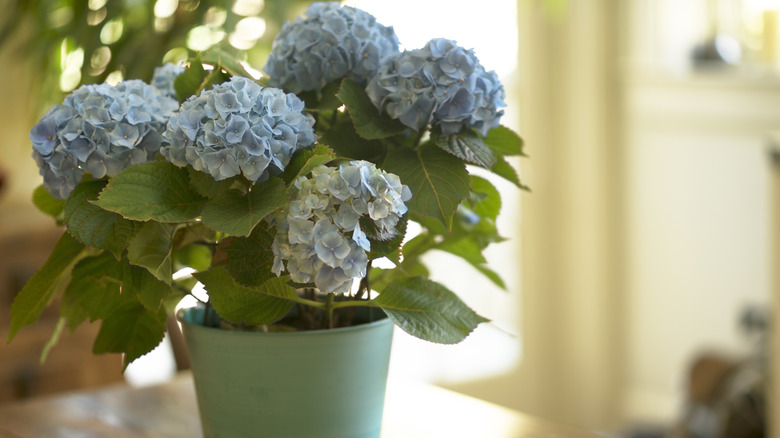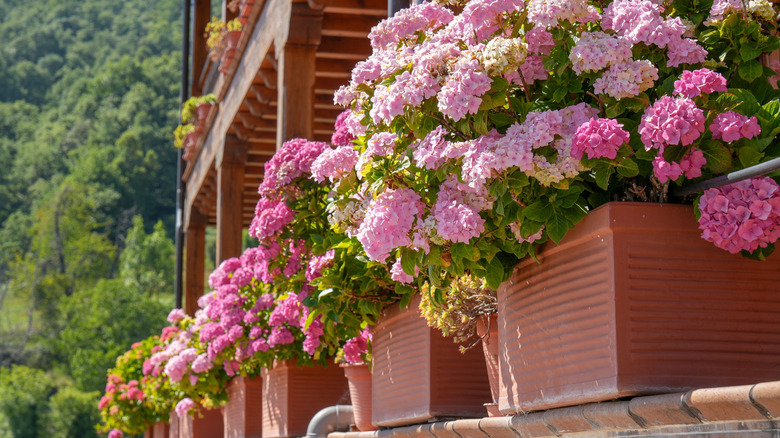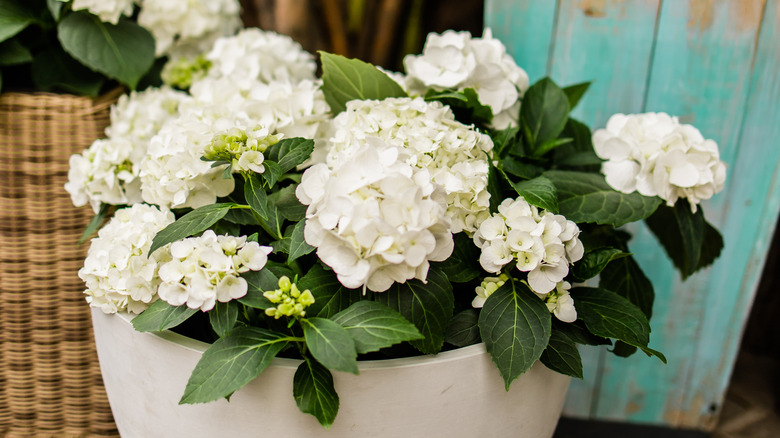Mistakes Everyone Makes When Growing Hydrangeas In Containers
It's easy to assume that large, shrubby flowers like hydrangeas can only thrive in spacious outdoor areas. While these colorful blooms do look stunning when planted directly in the garden or in the soil along a fence, they can also make a wonderful impression when kept in a flower pot. If you don't have a big yard or live in an apartment, growing hydrangeas in a container is the perfect way to enjoy these eye-catching flowers. Even if there's plenty of room to plant a hydrangea outside, potting these shrubs will allow you to instantly bring a bit of nature into your home. Plus, there are ways to change a hydrangea's color, so it can always match your decor. Growing hydrangeas in containers is pretty straightforward, but you will need to avoid a few key mistakes, like choosing the wrong size pot, placing it in the wrong place, or neglecting the flower's basic needs.
There are many different varieties of hydrangea, but in general the flowers call for basic potting soil, frequent watering, and about six hours of sun a day. However, even if you're able to provide these conditions, a potted hydrangea can suffer if you make the mistake of choosing a small pot that retains too much water, or if you place it somewhere that won't give it enough room or sunlight to grow.
Don't pick the wrong pot
After deciding what type of hydrangea you want to grow, the next step on the potted path is to pick the proper plant repository. Hydrangeas do best in perpetually moist soil, so it's important to opt for a container that will provide enough drainage to stop root rot caused by excess water. The container's material can also affect the soil's moisture levels. For instance, clay and terracotta pots tend to absorb water over time, so they can be a good choice if the hydrangeas will experience a lot of moisture. On the other hand, watertight, plastic pots might be better for hydrangeas kept in drier environments.
Another vital factor to consider when choosing a hydrangea pot is size. Hydrangeas are sizable shrubs, and need a container that is at least two feet across. Otherwise, their roots might become crowded, hindering future growth. To account for the expansive root system, hydrangeas need to be planted with at least a foot and a half of soil. Successfully growing a hydrangea usually requires starting with a healthy plant, so make sure you also avoid the worst time to plant store-bought hydrangeas. Keep in mind that if everything goes well, your potted hydrangea may eventually outgrow its container. At that point, you'll need to either start the search for a new pot, or let the flower leave the nest and try to make it on its own planted outside.
Remember the optimal plant placement
Hydrangeas may be relatively easy to grow, but it still takes work to get them situated in a pot, so don't let that effort go to waste by then sticking the contained shrub in a suboptimal location. Since most hydrangea varieties require at least six hours of sunlight a day, place the pot somewhere it won't be constantly stuck in the shade. At the same time, you don't want the soil to ever completely dry out, so also avoid putting potted hydrangeas anywhere they'll get too hot. One benefit of keeping hydrangeas in a container is that you can easily move it around and experiment with keeping the plant in different locations until you find a place that works. Hydrangeas can grow to be several feet tall, so where you keep your potted variety should also account for how much space it will eventually take up.
A final mistake potted hydrangea growers can make is thinking that their plants will be safe from exterior threats like bugs, mildew, and fungal diseases. These are some of the same common issues that can happen to hydrangeas in the garden, and with the right precautions, can be swiftly dealt with and avoided.


